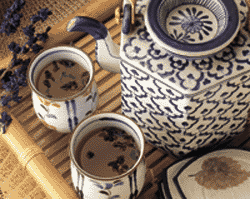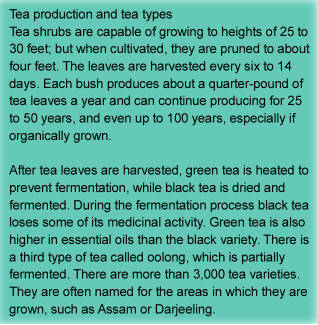
INfertility Workshop is getting a new face and a new place. Please visit us at InfertilityWorkshop.com/BLOG where it is all happening.

by Brigitte Mars, AHG
(American Herbalist Guild)
 Tea(Camellia sinensis) has a history of mythological proportions, no matter where inthe world you look. In the West, the word Thea, which is Greek for"goddess," gives tea its name. In the East, in China, a popular legend hasChinese emperor Shen Nung "discovering" tea when some leaves from a nearby teabush blew into a pot of water he was boiling for drinking water. In India, ancient legendtells the tale of Siddhartha Guatma, the founder of Buddhism, despairing after fallingasleep during meditation. He was so upset with himself that he ripped off his eyelids andthrew them to the ground where they rooted and grew into the first tea plant, with theshape of its leaves resembling the eyelid.
Tea(Camellia sinensis) has a history of mythological proportions, no matter where inthe world you look. In the West, the word Thea, which is Greek for"goddess," gives tea its name. In the East, in China, a popular legend hasChinese emperor Shen Nung "discovering" tea when some leaves from a nearby teabush blew into a pot of water he was boiling for drinking water. In India, ancient legendtells the tale of Siddhartha Guatma, the founder of Buddhism, despairing after fallingasleep during meditation. He was so upset with himself that he ripped off his eyelids andthrew them to the ground where they rooted and grew into the first tea plant, with theshape of its leaves resembling the eyelid.
Whether you believe any of these stories or not, we do know that the leaves from thisevergreen shrub have been consumed for over 4,000 years and that they have always beenknown for health.
Some historians assert that tea was first consumed in China to flavor water that wasboiled to protect people from bacterial contamination. In 1211 a.d., a Japanese monk namedEisai wrote a book called Maintaining Health by Drinking Tea in which he said,"Tea is a miraculous medicine for the maintenance of health. Tea has theextraordinary power to prolong life. Anywhere a person cultivates tea, long life willfollow. In ancient and modern times, tea is an elixir that creates the mountain dwellingimmortal." The sixteenth-century European explorers who first tried tea reported thatit was used to treat fever, headache, joint pain, and stomachache.
Green Tea
Today, green tea is getting the majority of the press for its positiveeffect on health. This is due to the power of its constituents, which include carotenoids,chlorophyll, polysaccharides, fats, vitamins C and E, manganese, potassium and zinc.However, experts agree that it is one type of constituent in particular that provides mostof the health benefits. These are polyphenols.
Polyphenols are members of the flavonoid family. They are catechins made of severalringlike structures. Each of these structures has chemicals attached to it called phenolgroups, hence the name polyphenols (poly means "many").
Of all three types of tea (green, black, and oolong), green tea contains the mostpolyphenols: about 15 percent to 30 percent of its weight. The polyphenols in green teaare recognized as anticarcinogenic, and this polyphenol content, along with the naturallyoccurring vitamin C, helps strengthen blood vessel walls.
Four of these polyphenols are of particular interest: epicatechin (EG),epigallocatechin (EGC), epicatechin gallate (ECG), and epigallocatechin gallate (EGCG). Ingreen tea, about half of the polyphenols are EGCG.
 EGCGis a powerful antioxidant and has been found to be 20 times stronger than vitamin E inprotecting brain lipids, which are very susceptible to oxidative stress. (Chem PharmBulletin 38 [1990]: 1049) In animal studies with mice, ECG has been shown to reducethe rate of lung, skin, and stomach cancer. (Preventative Medicine 21)
EGCGis a powerful antioxidant and has been found to be 20 times stronger than vitamin E inprotecting brain lipids, which are very susceptible to oxidative stress. (Chem PharmBulletin 38 [1990]: 1049) In animal studies with mice, ECG has been shown to reducethe rate of lung, skin, and stomach cancer. (Preventative Medicine 21)
Green tea is regarded as an antioxidant. The polyphenols, especially EGCG, prevent freeradical damage and have even been found to detoxify free radicals produced by theenvironmental toxin paraquat. (Carcinogenesis 10 [1989]: 1003)
As a whole, human studies indicate that consuming green tea can lower the rate ofesophageal cancer, mouth cancers, and gastric cancers. Recent research indicates thatgreen tea may reduce the risk of some forms of stomach cancer. Surveys of Japanese teadrinkers show that those who consume four to six cups of green tea a day have lower levelsof breast, esophageal, liver, lung, and skin cancers than those who consume less green teaor none at all.
At a meeting of the American Chemical Society in 1991, researchers reported that evencigarette smokers who consumed green tea had a 45 percent lower risk of cancer than nonteadrinkers. As an antitumor agent, green tea has an antimutation factor that helps DNA(deoxyribonucleic acid) to reproduce accurately rather than in mutated forms. Greentea’s catechin content is believed to be responsible for this effect. Even thoughJapan has one of the highest rates of smokers in the world, they have one of the lowestrates of lung cancer of any developed nation.
Green tea is a hypotensive, lowering blood pressure and helping to increase blood flowto the heart. Many Asians have long consumed green tea with meals, and this practice isnow showing to reduce arterial disease. Many heart attacks are brought on by bloodplatelet aggregation and green tea prevents the blood from "clumping together"and forming clots that can lead to stroke. One study indicates that 6,000 Japanese womenwho were nondrinkers and nonsmokers over 40 who drank about five cups of green tea a dayhad a 50 percent decrease in the risk of stroke. (Natural Health [March/April1994])
Whereas coffee can elevate cholesterol levels, green tea helps lower them.(HerbalGram 37 [1996]) The catechin content of green tea helps to break downcholesterol and increase its elimination through the bowels. Green tea also helps to keepblood sugar levels moderate.
Green tea has been used throughout history to improve ailments such asallergies, arteriosclerosis, asthma, cholera, colds, congestion, coughs, depression,diarrhea, digestive infections, dysentery, fatigue, hangovers, hepatitis, migraines, andtyphus. Tea helps to constrict the blood vessels, thereby reducing the throbbing pain ofan impending headache. In China, medicines made from the polyphenols in tea are used totreat hepatitis, nephritis, and leukemia.
Green tea helps to prevent dental decay by inhibiting the bacteria streptococcusmutans, which are responsible for plaque formation. It can also help inhibit the bacteriathat cause halitosis. Green tea is traditionally consumed after a meal to leave the mouthfeeling fresh and clean. It is currently being studied to see if it will help preventosteoporosis.
Green tea is also used topically and in this case is known as a styptic, which helpsstop bleeding when applied topically. It has been used lukewarm on open wounds, acne,athlete’s feet, and sunburn, and appears to protect the skin from damage fromultraviolet radiation exposure. Researchers are not yet sure why this works but think itmay be due to its antioxidant activity.
Excessive use of green tea can cause nervous irritability and aggravate ulcers, andthose with hypertension and insomnia should consider avoiding it.
With so many health benefits, it would be wise for more Americans to consider switchingfrom coffee to tea. I think I’ll go brew some tea right now. …
Brigitte Mars is an herbalist and nutritional consultantfrom Boulder, Colorado, who has been working with natural medicine for 30 years. Sheteaches herbology, has a weekly Boulder radio show called Naturally, and is theformulator for UniTea Herbs. She is the author of Elder; Herbs for Healthy Hair, Skin,and Nails (Keats Publishing), and of a comprehensive CD-ROM on herbs, TheHerbal Pharmacy. This is available from Hale Software at 1-800-856-6081. Get a freedemo program at http://www.halesoftware.com.
 BLOG
- ARTICLES
BLOG
- ARTICLES